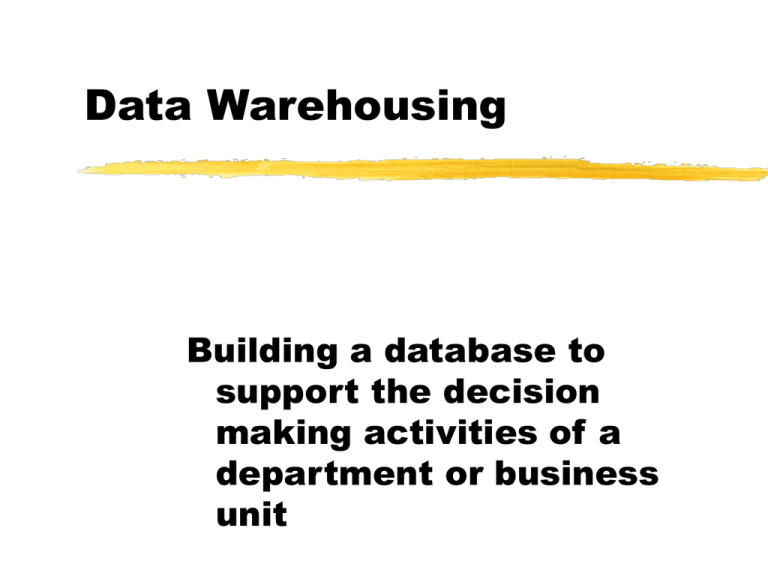PowerPoint Presentation - Data Warehousing: Building a database to support decision making
advertisement

Data Warehousing Building a database to support the decision making activities of a department or business unit Data Warehouse A read-only database for decision analysis –Subject Oriented –Integrated –Time variant –Nonvolatile consisting of time stamped operational and external data. Data Warehouse Purpose Identify problems in time to avoid them Locate opportunities you might otherwise miss Data Warehouse: New Approach An old idea with a new interest because of: Cheap Computing Power Special Purpose Hardware New Data Structures Intelligent Software Warehousing Problems Business Issues Data Quantity Data Accuracy Maintenance Ownership Cost Warehousing Problems Business Issues Database Issues DBMS Software Technology Complexity Warehousing Problems Business Issues Data Issues Analysis Issues User Interface Intelligent Processing EUC Data Architecture Enterprise Data Warehouse Data Marts Business Packages Needed Environment Understand DSS technology Understand relational databases Know company data resources Transformation and integration tools Possess DBA skills Install network and telecommunication hardware and software Possess front end software Possess meta-data navigation tools Two Approaches Classical Enterprise Database Typically contains operational data that integrates information from all areas of the organization. Data Mart Extracted and managerial support data designed for departmental or EUC applications Data Warehouse vs Operational Databases Highly tuned Real time Data Detailed records Current values Accesses small amounts of data in a predictable manner Flexible access Consistent timing Summarized as appropriate Historical Access large amounts of data in unexpected ways Separate Read Only Database Operational and decision support processing are fundamentally different. Flexible access Consistent timing Historical data Environmental references Common reference Front End Access Tailored access programs in user form, usually client-server General purpose GUI products (e.g. Access, PowerBuilder) Custom access routines Development Cycles Enterprise Traditional SDLC Requirements Driven Warehouse Iterative Development Data Driven Data Warehouse A database for departmental decision support. Contains detail data brought in through a feed and clean process. Data extracted from source files Data is integrated and transformed Data resides in a read-only database User access via a front end tool or application Data Warehouse Design Basics Must provide flexible access, “what if” processing, and extensive reporting on data subsets. Can tables be scanned in a reasonable time Can indexes be added as needed. If not, consider partitioning or summary tables Data Warehouse Design Basics Iterative Development with only part of the warehouse built at one time Used and modified with frequent user feedback and modification 1. Implement; test bias & completeness 2. Create and execute applications 3. Identify Requirements 4.Iterate Data Development Roles Data Analyst: Works with user groups to understand business and technical requirements. Data Architect: Manages company data. Must understand business needs as well as data implications. Analyst-Architect Communication Requirements Formal lines of communication Data warehouse council that meets monthly Analyst and architect retreat Formally identify analysts and architects Ensure comparable levels of personnel Both understand business requirements Architect goals available to analysts Analyst strategy and issues available to architects Data Warehouse Design Issues Small systems are easier to manage than large ones. Adding attributes is easier than changing or deleting them. Data WarehouseDesign: Proposed Changes Will the change disrupt the current system? Will the change add significantly more detail? Will the change disregard existing data? Will the change add a new table or change an existing one? What granularity? Does it fit the current data model? How much programming is required? How many resources will it consume? Data Warehouses Extracted Data Clean and feed. Internal data Summarized Historical Accuracy Integration External data Generated data Data Warehouse Extraction Issues Internal data often comes from separate operational databases. Reconcile formats Remove intelligent codes Verify accuracy Unify time stamps OLAP and MDBMS Online Analytic Processing Primarily relational models from which targeted extractions can be developed Complex for users Multidimensional DBMS Pre-modeled data cubes for efficient access Complex for design References V. Poe, Data Warehouse: Architecture is not Infrastructure, Database Programming and Design, July 1995 J. Bischoff, Achieving Warehouse Success, Database Programming and Design, July, 1994. W. Inmon, For Managers Only - A Tale of Two Cycles: Iterative development in the information warehouse environment, Database Programming and Design, Dec 1991.



